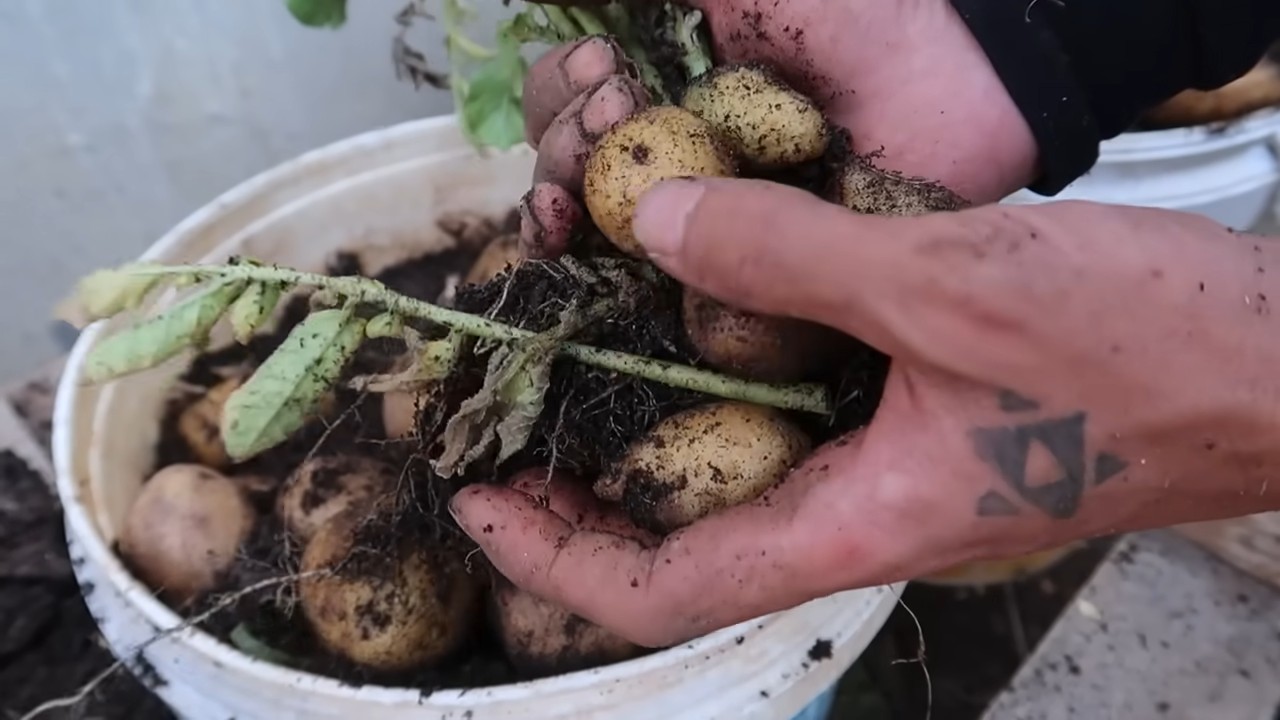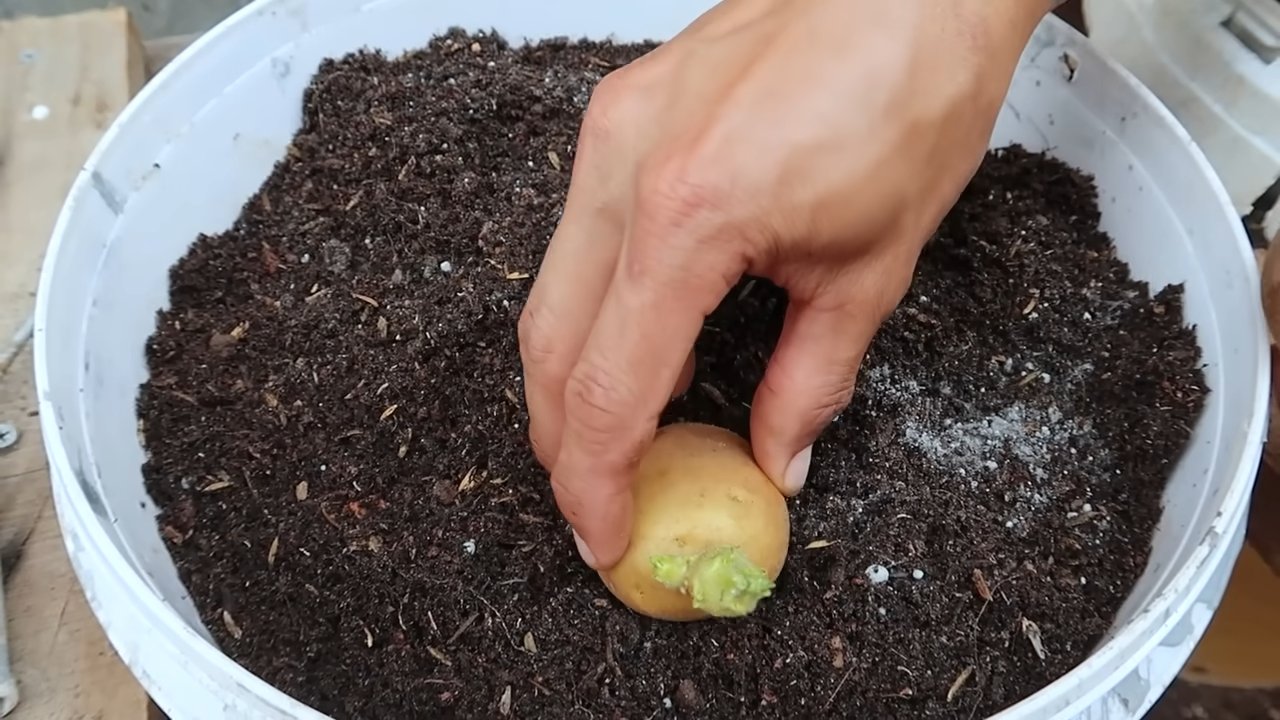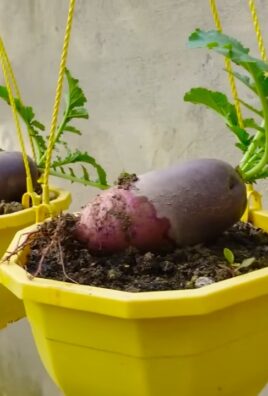Potato container gardening: ever dreamt of harvesting a mountain of spuds from your own backyard, even if you only have a tiny balcony or patio? Well, dream no more! This isn’t just about growing potatoes; it’s about unlocking a surprisingly simple and rewarding way to connect with nature, enjoy fresh, homegrown food, and impress your friends with your green thumb prowess.
For centuries, potatoes have been a staple food source, playing a vital role in cultures worldwide. From the Andean highlands where they originated to the Irish potato famine that shaped history, this humble tuber has a rich and complex past. Now, you can become a part of that story, cultivating your own crop with ease.
But why potato container gardening? Let’s face it, not everyone has acres of land to dedicate to a traditional potato patch. Container gardening offers a fantastic solution, allowing you to grow a substantial harvest in a small space. Plus, it’s incredibly satisfying to watch those leafy greens emerge and know that beneath the soil, a treasure trove of delicious potatoes is developing. This DIY guide will walk you through every step, from choosing the right container and soil to harvesting your bountiful crop. Get ready to dig in and discover the joy of homegrown potatoes!

Grow Your Own Spuds: A Beginner’s Guide to Potato Container Gardening
Hey there, fellow gardening enthusiasts! Ever dreamt of harvesting your own delicious, homegrown potatoes? Well, guess what? You don’t need acres of land to make that dream a reality. Container gardening is the answer, and it’s surprisingly easy! I’m going to walk you through everything you need to know to grow a bountiful potato crop right on your patio, balcony, or even a sunny windowsill. Get ready to dig in (pun intended!) and enjoy the satisfaction of eating potatoes you nurtured from start to finish.
What You’ll Need: The Potato Container Gardening Arsenal
Before we get our hands dirty, let’s gather our supplies. This is what I’ve found works best for me:
* A Large Container: This is crucial! Think big – at least 10 gallons, but 20 gallons is even better. The bigger the container, the more potatoes you’ll harvest. I’ve used everything from large plastic tubs to repurposed trash cans (with drainage holes, of course!). Fabric grow bags are also fantastic because they allow for excellent drainage and aeration.
* Seed Potatoes: These aren’t seeds, but rather small potatoes specifically grown for planting. You can find them at your local garden center or online. Choose certified disease-free seed potatoes for the best results.
* Potting Mix: Don’t use garden soil! It’s too heavy and compacts easily, which potatoes hate. Opt for a high-quality, well-draining potting mix. I often mix my own using equal parts peat moss, perlite, and compost.
* Fertilizer: Potatoes are heavy feeders, so a slow-release fertilizer is your friend. Look for one that’s specifically formulated for vegetables or has a balanced NPK ratio (like 10-10-10).
* Watering Can or Hose: Essential for keeping your potato plants happy and hydrated.
* Optional:
* Chitting Tray: For sprouting your seed potatoes before planting (more on this later).
* Gardening Gloves: To keep your hands clean.
* Trowel or Small Shovel: For planting and adding soil.
Choosing the Right Seed Potatoes: Variety is the Spice of Life (and Potatoes!)
Selecting the right seed potato variety is key to a successful harvest. Consider these factors:
* Days to Maturity: This tells you how long it will take for your potatoes to be ready for harvest. Early-season varieties mature in about 70-80 days, mid-season in 90-100 days, and late-season in 110-120 days.
* Potato Type: There are different types of potatoes, each with its own unique flavor and texture.
* Russets: Great for baking and frying.
* Yukon Golds: All-purpose potatoes with a buttery flavor.
* Red Potatoes: Hold their shape well when cooked, perfect for boiling and salads.
* Fingerling Potatoes: Small, elongated potatoes with a waxy texture.
* Disease Resistance: Choose varieties that are resistant to common potato diseases like blight and scab.
Some of my favorite varieties for container gardening include Yukon Gold, Red Norland, and Kennebec. Experiment and find what you like best!
Step-by-Step: Planting Your Seed Potatoes
Okay, let’s get planting! This is where the magic happens.
1. Chitting (Optional but Recommended):
Chitting, or pre-sprouting, your seed potatoes gives them a head start. It’s not essential, but I’ve found it leads to earlier and more abundant harvests.
* How to Chit: Place your seed potatoes in a cool, bright location (but not direct sunlight) for a few weeks. An egg carton or a chitting tray works well. You’ll notice small sprouts, called “eyes,” starting to emerge.
* Why Chit? Chitting encourages strong sprout development, which translates to faster growth once planted.
2. Preparing the Container:
* Drainage is Key: Make sure your container has plenty of drainage holes. Potatoes hate sitting in soggy soil.
* Initial Soil Layer: Fill the bottom of the container with about 4-6 inches of potting mix. Mix in a slow-release fertilizer according to the package directions.
3. Cutting the Seed Potatoes (If Necessary):
If your seed potatoes are large (bigger than an egg), you can cut them into smaller pieces. Each piece should have at least one or two “eyes.”
* Cutting Technique: Use a clean, sharp knife to cut the potato. Let the cut pieces air dry for a day or two to allow the cut surfaces to callous over. This helps prevent rot.
4. Planting the Seed Potatoes:
* Spacing: Place the seed potato pieces (or whole small seed potatoes) on top of the soil, with the “eyes” facing upwards. Space them about 8-10 inches apart. If you’re only planting one seed potato, place it in the center of the container.
* Covering: Cover the seed potatoes with another 4-6 inches of potting mix.
5. Watering:
* Water Thoroughly: Water the container well after planting, until water drains out of the bottom.
The “Hilling” Process: Encouraging More Potatoes
This is where the magic really happens! Hilling is the process of adding more soil to the container as the potato plants grow. This encourages the plants to produce more potatoes along the buried stems.
1. Waiting for Growth:
* Be Patient: It will take a few weeks for the potato plants to emerge from the soil.
* Water Regularly: Keep the soil consistently moist, but not waterlogged.
2. The First Hilling:
* When to Hill: Once the potato plants are about 6-8 inches tall, it’s time for the first hilling.
* How to Hill: Add more potting mix to the container, burying the stems of the plants up to the bottom set of leaves. Leave the top leaves exposed.
3. Subsequent Hillings:
* Repeat the Process: Continue hilling every 2-3 weeks as the plants grow taller.
* Almost to the Top: Eventually, you’ll fill the container almost to the top with soil.
Caring for Your Potato Plants: Sunshine, Water, and Love
Now that your potatoes are planted and hilling is underway, it’s time to focus on providing the right care.
* Sunlight: Potatoes need at least 6-8 hours of sunlight per day. Place your container in a sunny location.
* Watering: Water regularly, especially during hot, dry weather. The soil should be consistently moist, but not soggy. Check the soil moisture by sticking your finger into the soil. If the top inch feels dry, it’s time to water.
* Fertilizing: Continue to fertilize your potato plants every few weeks with a balanced fertilizer. Follow the package directions.
* Pest Control: Keep an eye out for pests like aphids, potato beetles, and flea beetles. Handpick them off the plants or use an organic insecticide if necessary.
* Disease Prevention: Proper watering and good air circulation can help prevent diseases. If you notice any signs of disease, such as yellowing leaves or spots, remove the affected leaves immediately.
Harvest Time: The Sweet Reward
After all your hard work, it’s finally time to harvest your potatoes!
* When to Harvest: The timing of your harvest will depend on the variety of potatoes you planted and when you planted them. Generally, early-season varieties are ready to harvest in about 70-80 days, mid-season in 90-100 days, and late-season in 110-120 days.
* Signs of Readiness: The potato plants will start to flower, and the foliage will begin to turn yellow and die back. This is a sign that the potatoes are ready to harvest.
* Harvesting Technique: Gently dig around the base of the plants with your hands or a small trowel. Be careful not to damage the potatoes.
* Enjoy Your Harvest: Wash the potatoes and enjoy them fresh! Store any remaining potatoes in a cool, dark, and dry place.
Troubleshooting: Common Potato Growing Problems
Even with the best care, you might encounter some problems along the way. Here are a few common issues and how to address them:
* Yellowing Leaves: This could be a sign of overwatering, underwatering, nutrient deficiency, or disease. Check the soil moisture and adjust your watering accordingly. Fertilize the plants if necessary. If you suspect disease, remove the affected leaves.
* Potato Beetles: These pests can quickly defoliate your

Conclusion
So, there you have it! Transforming a simple container into a thriving potato patch is not only incredibly rewarding but also surprisingly easy. We’ve walked you through the steps, highlighting the benefits of this space-saving, high-yield gardening method. Forget sprawling gardens and back-breaking digging; container gardening for potatoes offers a practical and accessible solution for anyone, regardless of their gardening experience or available space.
Why is this DIY potato container gardening trick a must-try? Because it empowers you to grow your own fresh, delicious potatoes right at your doorstep. Imagine the satisfaction of harvesting your own crop, knowing exactly where your food comes from and how it was grown. Plus, it’s a fantastic way to reduce your carbon footprint and connect with nature, even in the heart of the city.
But the beauty of this method lies in its adaptability. Feel free to experiment with different potato varieties. Russets are great for baking, Yukon Golds are perfect for boiling, and fingerling potatoes add a touch of elegance to any dish. You can also adjust the size of your container to suit your needs and available space. A smaller container is ideal for a patio or balcony, while a larger container can accommodate more plants and yield a bigger harvest.
Consider adding companion plants to your potato container. Marigolds can help deter pests, while basil can improve the flavor of your potatoes. Get creative and personalize your container garden to reflect your own unique style and preferences.
Don’t be afraid to get your hands dirty and embrace the learning process. Gardening is all about experimentation and discovery. You might encounter challenges along the way, but the rewards are well worth the effort. And remember, there’s a wealth of information available online and in your local community to support you on your gardening journey.
We wholeheartedly encourage you to give this DIY potato container gardening trick a try. It’s a fun, educational, and ultimately delicious experience. Once you’ve harvested your first crop of homegrown potatoes, you’ll be hooked!
We’re eager to hear about your experiences. Share your photos, tips, and stories in the comments below. Let’s create a community of container gardening enthusiasts and inspire others to grow their own food. What potato varieties did you choose? What challenges did you face, and how did you overcome them? What delicious recipes did you create with your homegrown potatoes? We can’t wait to hear from you!
Variations and Enhancements
* Vertical Gardening: Explore using stacked containers or vertical planters to maximize space and create a visually stunning potato tower.
* Organic Fertilizers: Opt for organic fertilizers like compost tea or worm castings to nourish your potato plants and promote healthy growth.
* Watering Systems: Consider installing a drip irrigation system to ensure consistent watering and prevent overwatering.
* Potato Grow Bags: Experiment with potato grow bags, which are specifically designed for growing potatoes and offer excellent drainage and aeration.
Final Thoughts
Growing potatoes in containers is a fantastic way to enjoy fresh, homegrown produce, even if you have limited space. It’s a rewarding and educational experience that connects you with nature and empowers you to take control of your food supply. So, grab a container, some seed potatoes, and get ready to embark on a delicious gardening adventure!
Frequently Asked Questions (FAQ)
What type of container is best for growing potatoes?
The ideal container for potato container gardening should be at least 20 gallons in size and have drainage holes. A plastic container, a large bucket, a half-barrel, or even a repurposed trash can will work. The key is to ensure adequate drainage to prevent waterlogging, which can lead to root rot. Dark-colored containers can absorb more heat, potentially warming the soil, which can be beneficial in cooler climates. However, in hotter climates, lighter-colored containers might be preferable to prevent the soil from overheating. You can also use grow bags, which are specifically designed for growing potatoes and offer excellent drainage and aeration.
What kind of soil should I use for potato container gardening?
Use a well-draining potting mix that is rich in organic matter. Avoid using garden soil, as it can be too heavy and compact, hindering root growth. A good potting mix will retain moisture while allowing excess water to drain away. You can also amend your potting mix with compost or other organic materials to improve its fertility and drainage. A slightly acidic pH (around 6.0 to 6.5) is ideal for potatoes.
How many seed potatoes can I plant in one container?
Generally, you can plant 2-3 seed potatoes in a 20-gallon container. Space them evenly around the container, ensuring they have enough room to grow. If you’re using a larger container, you can plant more seed potatoes, but be sure to provide adequate spacing to prevent overcrowding. Overcrowding can lead to smaller potatoes and reduced yields.
How often should I water my potato plants in containers?
Water your potato plants regularly, especially during hot and dry weather. The soil should be consistently moist but not waterlogged. Check the soil moisture by sticking your finger about an inch deep into the soil. If it feels dry, it’s time to water. Avoid overwatering, as this can lead to root rot. A good rule of thumb is to water deeply when the top inch of soil feels dry.
How much sunlight do potato plants need?
Potato plants need at least 6-8 hours of sunlight per day. Choose a location that receives plenty of sunlight throughout the day. If you live in a particularly hot climate, you may need to provide some afternoon shade to prevent the plants from overheating. Insufficient sunlight can lead to leggy growth and reduced yields.
When and how should I “hill” my potato plants in containers?
“Hilling” is the process of adding more soil to the container as the potato plants grow. This encourages the plants to produce more potatoes along the buried stem. When the potato plants are about 6-8 inches tall, add a few inches of soil to the container, leaving only the top few leaves exposed. Repeat this process every few weeks as the plants continue to grow.
How long does it take for potatoes to grow in containers?
It typically takes 70-100 days for potatoes to mature in containers, depending on the variety. You can start harvesting “new potatoes” (small, immature potatoes) after about 70 days. For larger, more mature potatoes, wait until the plants have flowered and the foliage begins to die back.
How do I know when my potatoes are ready to harvest?
The best way to tell if your potatoes are ready to harvest is to wait until the foliage begins to die back. This indicates that the potatoes have reached maturity. You can also gently dig around the edges of the container to check the size of the potatoes. If they are the size you desire, you can harvest them.
What are some common pests and diseases that affect potato plants in containers?
Common pests that affect potato plants include aphids, potato beetles, and flea beetles. Diseases include early blight, late blight, and potato scab. You can prevent these problems by using healthy seed potatoes, providing good air circulation, and avoiding overwatering. If you encounter pests or diseases, you can treat them with organic pesticides or fungicides.
Can I reuse the soil from my potato container for other plants?
Yes, you can reuse the soil from your potato container for other plants, but it’s important to amend it with fresh compost or other organic matter to replenish the nutrients. Potatoes are heavy feeders, so they can deplete the soil of nutrients. You should also avoid planting potatoes in the same container year after year, as this can increase the risk of disease. Crop rotation is a good practice to maintain soil health.





Leave a Comment